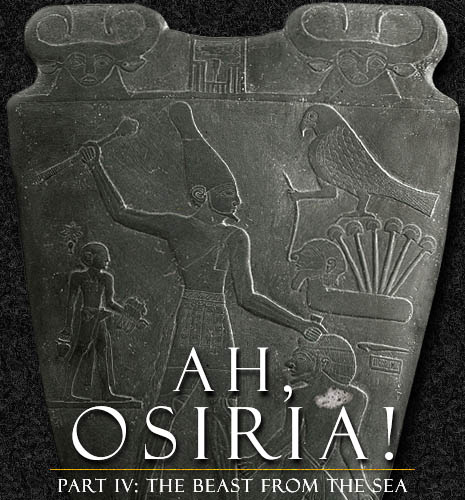
Editorial
|
Press Releases
|
Book Reviews
|
Fragments
NEW! Artifacts: Coral Castle
Grand Canyon II
|
Giants IV
|
Osiria IV
Register
for our Hall of Records Newsletter!
Questions? Comments? Suggestions? Advertising? Press Releases?
Contact us!
Part I: The Athenian Empire
|
Part II: Antediluvian Egypt
|
Part III: Nimrod Hunting
NEW!
Ah, Osiria! Discussion Board
(Requires Registration)
Pharaoh Narmer
|
The Great Game
|
The Fisher Kings
|
The Beast from the Sea
The Lord of the Rings Cipher
|
Endgame
Osiria Links
|
Osiria Books
|
Osiria Audio
|
Osiria Video
|
Osiria Collectibles
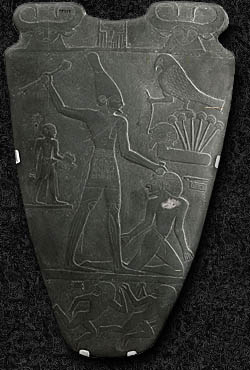
|
|
|
The mysterious
"Narmer Palette",
which is believed to commemorate the first unification of Egypt under the equally mysterious Pharaoh Narmer, ca. 3200 BC. The palette is two-sided, both sides providing a wealth of information about this ancient king of Egypt.
Click here
to view an interactive version.
|
|
h, Assyria! The rod of mine anger! The staff in your hand is my indignation!" Thus spake God through the prophet
Isaiah,
who prophesied that the LORD would raise up
the Assyrians
to smite the Israelites, who by that time
( 734 BC )
had slidden into apostasy and forgotten God. And smite them they did, carrying away the northern ten tribes of Israel into captivity. And so great did God's indignation burn against the northern ten tribes, that they never again returned to the land of Israel, remaining scattered among the nations as a "wild olive tree" to this day.
However, this was not the first time that God had caused a great nation to raise up the rod to smite the nations in His wrath (nor would it be the last). As we saw in
Part III,
in ancient times a new power had arisen out of Egypt and had conquered and civilized all of Mesopotamia and the ancient Near East.
This was the "pre-dynastic" line of Egyptian kings that had descended from the
giant
Egyptian demigod known as
Osiris,
the first great king and world dictator of the world
after the Flood. It was Osiris' goal to reclaim the lost world from before the Flood, particularly the region around
the Mediterranean
that we have entitled,
"Osiria"
after Osiris himself. To this end, Osiris took up the rod of war in order to spread his "Pax Osiria" throughout the ancient world, becoming the "rod of God's anger" and a terrible scourge to all who opposed him.
But even Osiris, though undoubtedly long-lived, was still but flesh, and in time he too, died. However, in death he left behind a legendary legacy, a legacy that included a global civilization that shows his handiwork on earth, and a constellation — Orion — that remembers his name in the heavens. But the most important leg of Osiris' triune legacy was a dynasty of semi-divine kings, and the most famous of these "pre-dynastic" kings, his descendants, was Pharaoah Narmer, from whose name and fame the name "Nimrod" was undoubtedly derived.

|
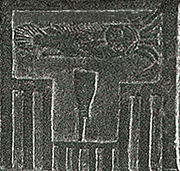 |
|
The
serekh
of Pharaoh Narmer, found at the top of the Narmer Palette. The serekh is a form of writing the names of pharaohs that preceded the more commonly known "cartouche". Narmer's serekh is also our source for the pharaoh's name, as nar is the word "catfish" (top), and mer is the word "chisel" (center). The two structures on either side of the serekh most likely indicate thrones, or towers, as they are typically represented in Egyptian art. All together, Pharaoh Narmer is portrayed as a "beast from the sea", a bottom-feeding fish, who is also an architect, a "builder of cities", as indicated by the chisel. Adding in the two towers on either side of the serekh, we get the idea that Narmer has either built these two towers, or intends to destroy them — or both. The image at the bottom between the two towers may be a gate.
Roll over the image to see an outline version of the serekh.
|
|
|
|
|
Pharaoh Narmer
rose up out of the dust of history around 3200 b.c., and his mighty legacy was to be the first pharaoh to conquer upper Egypt and unite the two lands, upper and lower Egypt, into one. Narmer gained reknown as a great conqueror and a builder of cities, and is remembered by history as the first king of the first dynasty of Egypt.1
Though there are a few sources that mention Pharaoh Narmer, by far the most important archaeological relic that gives us the most information about him is the famed "Narmer Palette" (above). Carved out of dark, greenish slate, this palette is believed to have been a ritual offering to the gods given by Narmer as thanks for his successful conquest of southern, or "upper" Egypt from his base in northern, or "lower" Egypt.
Both sides of the mysterious artifact are filled with very important information about the rise and rule of Narmer. But the most striking part of the palette is
the front,
or "obverse" side of the palette, which shows Narmer in the classic "upraised arm" pose. This pose became the signature stance for all pharaohs after him, routinely showing up on war monuments showing the pharaoh victorious over his enemies. On the top of both the obverse and the reverse of the palette, however, is the most important clue to this Pharaoh's legacy — his
serekh (left),
a specialized way of writing the names of Egyptian royalty, similar to but preceding the more commonly known
cartouche
in usage.
Narmer's serekh is unusual in that it contains not a heroic lion or a fierce falcon, but a seemingly benign catfish surmounting a chisel. It is from this catfish and chisel that we derive Narmer's name — in ancient Egyptian, the word for "catfish" was nar, and the word for "chisel" was mer. Unfortunately, we do not know for sure if he was referred to as "Narmer", or if these symbols were meant only to describe his character and background — his "fame" rather than his name. Much speculation has been offered as to the meaning of these hieroglyphs, but until now little light has been shed on these enigmatic symbols.
Narmer's serekh is built of two towering "throne" hieroglyphs that are facing each other, enclosing and symbolically limiting the power of the catfish that is bound in between these two pillars in a sort of "prison". The "catfish" is not sitting idly, however — it appears that it is attempting to remove itself from its prison, with the aid of a chisel that is set against what appears to be a sort of "black gate" connecting the two towers. More than just a symbol of building, then, whether of cities or of nations, this chisel is a tool that the "catfish" appears to be using in an attempt to escape its ancient bonds, and become, if you will, a "free" mason.
The catfish is also an interesting symbol in that it is a bottom-feeding fish that lives at the bottom of the sea. Could it be that during his tutelage in his early years in Egypt that Moses had heard the story of the rise and rule of Narmer, a story that he cleverly alluded to when he wrote about how the "serpent" had been cursed to crawl in and eat dust forever?
( Gen. 3:14-15 ).
Moreover, the fact that this type of fish lives at the bottom of the sea may be a subtle allusion to the fact that Narmer believed that he was of divine parentage, descended from
the ancient giant kings
from
the world before the Flood
who now lay buried under sea, silt and sediment. The abyssal trenches at the bottom of the oceans were indeed believed to be one of the holding places of the fallen angels who had rebelled against God in the world before the Flood, where they were entrapped and imprisoned in "chains of darkness" until the day of judgment.
( 2 Peter 2:4-5; Jude 1:5-6; Rev. 9:13-15 )2
In sum, then, these symbols may indicate that Narmer believed himself to be the
reincarnation
of one of the ancient fallen angels from the world before the Flood, one who had returned to break through
the ancient barriers
erected by God to keep him in check and begin the process of rebuilding the world as it had been before the Flood. This great, warrior, conqueror, and builder of cities was most likely the conqueror who became known in Mesopotamia as "Nimrod", indicating that Narmer may have conquered not only upper Egypt, but also large parts of the ancient Near East in his quest to rebuild the world as it had been before the Flood.
Interestingly,
the name of Narmer's son,
Menes means, literally, "gaming board".3 As such, it may well be that the rise of Narmer was the first move in a grand strategy, or "great game" devised by the fallen angels in a bid to return the world to the way it had been before the Flood, where semi-divine kings ruled over a world enslaved. Menes and his descendants were thus successive genetic "steps" in this
global game of "genetic chess",
with the eventual goal of enslaving the nations under a one-world government run by a group of semi-divine rulers sometime in what was then in the distant future.

|
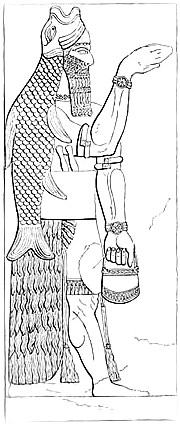 |
|
Oannes, the original "Beast from the Sea". Oannes was a half-man half-fish deity and god of the sea cognate to Ea of the Mesopotamians, Dagon of the Philistines, Neptune of the Greeks and Poseidon of the Romans. Oannes is believed to have arisen out of the sea to impart the secrets of civilization
to mankind in the world after the Flood, and was most likely the father of Osiris and the next generation of
Rephaim giants in the world
after the Flood.
|
|
|
|
|
But who was behind this genetic game, and why?
As we have seen,
the fallen angels who had attempted to create a kingdom on Earth apart from the control of God in the world before the Flood had been imprisoned by God for their rebellion in the deep parts of the Earth, which included the abyssal trenches at the bottom of the oceans. Later, however, they appear to have escaped their imprisonment to some extent, and influence mankind to follow them and their wicked ways once more. The question remains, however, does an event of such importance as the reappearance of the fallen angels on Earth appear anywhere in the ancient histories and mythologies of Earth? In fact, it does, in the Sumerian legend of Oannes, the original "fisher king":
At Babylon there was (in these times) a great resort of people of various nations, who inhabited Chaldaea, and lived in a lawless manner like the beasts of the field. In the first year there appeared, from that part of the Erythraean sea which borders upon Babylonia, an animal [endowed with human reason], by name Oannes, whose whole body (according to the account of Apollodorus) was that of a fish, that under the fish's head he had another head, with feet also below, similar to those of a man, subjoined to the fish's tail. His voice too, and language, was articulated and human, and a representation of him is preserved even to this day.
"This Being was accustomed to pass the day among men; but took no food at that season; and he gave them an insight into letters and sciences, and arts of every kind. He taught them to construct cities, to found temples, to compile laws, and explained to them the principles of geometrical knowledge. He made them distinguish the seeds of the earth, and shewed them how to collect the fruits; in short, he instructed them in everything which could tend to soften manners and humanize their lives. From that time, nothing material has been added by way of improvement to his instructions. And when the sun had set, this Being Oannes, retired again into the sea, and passed the night in the deep; for he was amphibious. After this there appeared other animals like Oannes.
- Berossus, from Ancient Fragments 4
Oannes first appeared to the ancient Sumerians sometime in the fourth millennium b.c. This of course corresponds very closely with the introduction of letters and writing in both ancient Egypt and ancient Mesopotamia. The city of Kish, in ancient Mesopotamia, as we saw in
Part III,
was the first known place on Earth to have a system of writing, around 3500 b.c. Also, as we saw in
Part I
Osiris, like Oannes, also came to mankind, who at that time was barbarous and uncivilized, and taught them how to be civilized — what to eat and drink, how to read and write, and so forth. Osiris also traveled to other lands and civilized them as well, around the same time that Oannes was civilizing the Mesopotamians. And though Osiris is not described in the texts as having come forth from the sea, the gods who came before him had come forth from Nun, the god of the primordial sea, so the connection with the sea is not absent in Osiris' mythology.
Oannes, then can be equated with Osiris of the Egyptians, Dagon (the fish god) of the Philistines, Ea of the Mesopotamians, and Neptune and Poseidon of the Greek and Roman myths. Each of these gods (or is it one sea god with many names) also had a hand in the creation of man, and in his continuing development, getting involved at certain points in order to influence the path on which mankind walked over time. Moreover, as we saw in
Part IV
of our series on Atlantis, Poseidon had actually mated with a human woman to create a race of giants that had ruled over this legendary isle. If Oannes were Poseidon returned, then it is most likely that this "beast from the sea" had returned to recreate the race of the
giants
that had ruled the world before the Flood — a race of semi-divine kings who would eventually attempt to conquer and rule the entire Earth. And the first major step in recreating the world as it had been before the Flood, where a handful of giants ruled over a world enslaved, was Pharaoh Narmer, the legendary "Nimrod", who was part of a special line of "Fisher Kings" whose eventual goal was the conquest and enslavement of the entire world.

|
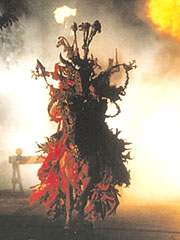 |
|
Terry Gilliam's interpretation of the Fisher King as Red Knight. An allusion to the red horseman of the apocalypse, perhaps?
From the film,
The Fisher King.
|
|
|
|
|
But Narmer was not the only descendant of Osiris, "the Beast from the Sea". Osiris/Oannes had traveled throughout the Mediterranean and the ancient Near East civilizing the barbaric peoples, teaching them reading and writing, giving them laws, and so forth. However, not only did he leave behind a legacy of civilization, but he also sired a line of kings, through whom he would rule the nations, to this day — "one ring to rule them all", as it were.
This unholy bloodline was to form an aristocracy of "blue bloods" that to this day rules over the nations, despite the facade of democracy that has recently allowed some degree of liberty from their dictatorial rule. These "Fisher Kings" have ruled the world ever since the rise of Osiris and of Narmer, a line of modified humans whose genetic ancestry has been altered by the fallen angels to make them taller, stronger, smarter and/or more aggressive than those peoples over whom they rule — just like the ancient
giants
from the world
before the Flood.
Lawrence Gardner gives an excellent example of intermarriage between humans and the mysterious "beast from the sea" in his book,
Bloodline of the Holy Grail,
The Sicambrian Franks, from whose female line the Merovingians emerged, were associated with Grecian Arcadia before migrating to the Rhineland.... The Arcadian legacy was responsible for the mysterious sea beast — the Bistea Neptunis — as symbolically defined in the Merovingian ancestry. The relevant sea-lord was King Pallas, a god of old Arcadia, whose predecessor was the great Oceanus. In fact, the concept dated back as far as the ancient kings of Mesopotamia, who were said to be born of Tiamat, the great mother of the primordial salt waters. The immortal sea beast was said to be ever incarnate in a dynasty of ancient kings, whose symbol was a fish. This became an emblem of the Merovingian kings, whose symbol was a fish.5
The infamous, heretical
Merovingians
believed that they were both the descendants of Jesus and the descendants of a "beast from the sea", a Neptune-like creature identical to Oannes that they believe inseminated women of their line and continued to promote and support them behind the scenes as rulers over all of Europe. Though they were clearly not descendants of Jesus, as we have seen, the concept that they were the descendants of a fish-like creature has clear antecedents in ancient history.
Charlemagne,
one of the most famous of the Merovingians, was actually an exceptionally tall and strong giant of a man, who for a period actually controlled most of modern Europe. Interestingly, they actually traced their line not only to ancient Greece, but all the way back to ancient Mesopotamia, where Osiris/Oannes had begun the ancient line of kings sometime during the fourth millennium b.c. This line continues on even today, to
modern royalty
and even to "elected" leadership.

|
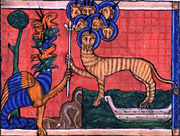 |
|
A miniature from the Burckhardt-Wildt Apocalypse depicting the events described in
Revelation 13,
which describes a "beast" emerging from the sea, and another emerging from the land. Note the "fleur-de-lis" trident, ancient symbol of Poseidon, and of the Merovingians. Image from
The Detroit Institute of Arts
|
|
|
|
|
The end goal of the "great game" that Azazel, Semjaza, and the rest of the fallen angels are playing is the resurrection of the world as it was before the Flood, with themselves as its absolute rulers. In order to do this, they first had to overcome the ancient barriers that have held them ever since they had been imprisoned by God after the Flood as punishment for corrupting the world. In order to achieve this goal, they created a race of modified humans whom they have been using to quietly take control over the whole world in secret, from behind the scenes. As shown in Narmer's serekh, these fallen angels have been using this strategem to slowly chisel away at the barriers that God had set up to keep them imprisoned. It is from this concept that the term "freemasons" was derived — the freemasons, and related groups have been diligently chipping away at the two "towers" that God had chained them to after the Flood. They are called "free" masons as they are chipping away at God's laws in order to be "free" of his rule. Quietly, behind the scenes, for literally thousands of years, these secretive heretical groups have been consolidating money and power in order to make a bid for world rulership, looking for the day when they could knock down the two towers that have been holding them imprisoned for so many thousands of years. Thus, the end game of this great game will involve the destruction of two towers as the final prelude to final resolution of the great game and their total takeover of the entire world.
This milestone was fulfilled in the destruction of the two towers of the World Trade Center complex. And in this event, we can also understand the meaning of some of the more enigmatic parts of the Book of Revelation:
1After this I saw another angel coming down from heaven. He had great authority, and the earth was illuminated by his splendor.
2With a mighty voice he shouted: �Fallen! Fallen is Babylon the Great! She has become a home for demons and a haunt for every evil spirit, a haunt for every unclean and detestable bird.
3For all the nations have drunk the maddening wine of her adulteries. The kings of the earth committed adultery with her, and the merchants of the earth grew rich from her excessive luxuries.�
4Then I heard another voice from heaven say: �Come out of her, my people, so that you will not share in her sins, so that you will not receive any of her plagues;
5for her sins are piled up to heaven, and God has remembered her crimes.
6Give back to her as she has given; pay her back double for what she has done. Mix her a double portion from her own cup.
7Give her as much torture and grief. as the glory and luxury she gave herself. In her heart she boasts, "I sit as queen; I am not a widow, and I will never mourn."
8Therefore in one day her plagues will overtake her: death, mourning and famine. She will be consumed by fire, for mighty is the Lord God who judges her.
9�When the kings of the earth who committed adultery with her and shared her luxury see the smoke of her burning, they will weep and mourn over her.
10Terrified at her torment, they will stand far off and cry: "Woe! Woe, O great city, O Babylon, city of power! In one hour your doom has come!"
( Rev 18:1-10 )
The description of the great prostitute in the preceding chapter of Revelation (17 ), describing her as both "Babylon" and as "a great city" that rules over the kings of the Earth — a very large city, a very rich city, a major cultural capitol, a major port city and numerous other clues to complicated to get into here. All together, the only city that fits the description of this "Great City" is in fact New York City, the only city in the world that could realistically be described in this manner. Moreover, the description of "the smoke of her burning" and the wails of the merchants, "in one hour your doom will come" describes perfectly the events of 9/11. The wailing of the world's merchants is particularly apt, since these were the World Trade Towers, which means their destruction formed a major disruption for world trade for "the merchants of the earth" (v.11). Moreover, the second trade tower fell almost exactly one hour after the first had fallen — "in one hour your doom has come". Finally, the angel's double usage of the word "fallen" tends to support the idea that he was describing the falling of not one, but two towers. "Fallen! Fallen is Babylon the Great!" (v.2).
In
Revelation 17,
the woman is shown as riding a "beast" that had come up out of the "Abyss", which means the abyssal plains at the bottom of the ocean. The woman, who holds a golden cup full of blood and abominations, is likely a symbol of the false, gnostic anti-church that has been shadowing and attempting to corrupt the true church of God for thousands of years. Her destruction by this "beast from the sea" was likely at least partly fulfilled in the events of 9/11, and may be completed in a future action or actions initiated by this beast. The description of this "beast from the sea" is given in greater depth in
Revelation 13:
1And I saw a beast coming out of the sea. He had ten horns and seven heads, with ten crowns on his horns, and on each head a blasphemous name.
2The beast I saw resembled a leopard, but had feet like those of a bear and a mouth like that of a lion. The dragon gave the beast his power and his throne and great authority.
3One of the heads of the beast seemed to have had a fatal wound, but the fatal wound had been healed. The whole world was astonished and followed the beast.
4Men worshiped the dragon because he had given authority to the beast, and they also worshiped the beast and asked, �Who is like the beast? Who can make war against him?�
5The beast was given a mouth to utter proud words and blasphemies and to exercise his authority for fortytwo months.
6He opened his mouth to blaspheme God, and to slander his name and his dwelling place and those who live in heaven.
7He was given power to make war against the saints and to conquer them. And he was given authority over every tribe, people, language and nation.
8All inhabitants of the earth will worship the beast�all whose names have not been written in the book of life belonging to the Lamb that was slain from the creation of the world. ( Rev 13:1-8 )
The "beast from the sea" is of course a world empire dominated by seven great nations, or "heads" who are controlled by the descendants of Osiris, the original "beast from the sea". It is the endgame of his "great game" that he had started thousands of years before with the goal of freeing himself from his ancient bonds and placing himself as ruler over the entire Earth. And for a time, times, and half a time, Azazel's master plan will succeed.

|
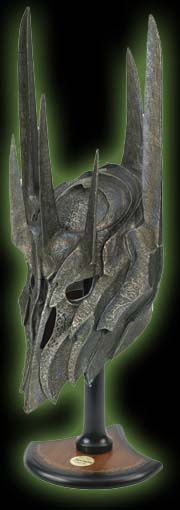 |
|
The helmet of Sauron, as portrayed in the movie, The Lord of the Rings. The design is unusual in that the faceplate
appears to have tentacles reminiscent of the image of the catfish found on
Pharaoh Narmer's serekh, and indeed looks like the catfish portrayed there
when viewed from above, the shape of the eyes and the curve on the top of the helmet also correlating. Could Tolkien and/or the designer
of this helmet have been making a subtle allusion to the mysterious Pharaoh Narmer, the "Catfish King", which may have been Tolkien's
inspiration for Sauron?
|
|
|
|
|
|
 |
|
The One Ring
|
|
|
|
|
J.R.R. Tolkien's book,
The Lord of the Rings,
was the story about how a powerful spirit by the name of
Sauron
(Quenya Elvish, literally, "the Abomination") was seduced by the dark side into coming to Earth (or "Middle-Earth", in this case), in order to found a kingdom of his own apart from the control of the higher powers (the "Valar" in the Tolkien universe). To achieve his goal of the total domination of the world, Sauron created a series of magic rings and handed them out to the rulers of the Earth as a gift from a "friend". Unbeknownst to them, however, Sauron had created a master ring that he intended to use to control the bearers of the other rings that he had given to the various peoples of Middle-Earth. Into this ring he poured most of his power, hatred, malice, and desire to dominate others, and he then attempted to use this "One Ring to rule them all" to effectively remote-control the leaders to whom he had given the other, lesser rings. Most of these leaders sensed his evil intentions and did not wear the rings he gave them, but some — lesser men who were like Sauron in that they sought to control and dominate others — fell into his trap and became his slaves. And through his ring he was able to control these kings of men to help him to perform his dark will — to control the Earth, enslave its peoples, and cover the entire world in a second darkness.
However, Sauron was defeated in battle in a grand alliance of peoples who banded together to destroy him once and for all. His armies were defeated, and his mighty ring was cut from his finger. Since the ring held most of his power, personality and will, without the ring he was no longer able to achieve corporeal form, and instead became a shadowy demon, working behind the scenes to accomplish his goals until he could retrieve his ring.
Because part of his essence was within the ring, it was highly intelligent and able to manipulate people and events also. To this end, it betrayed the man who had defeated Sauron and taken the ring, causing him to be killed and fall into a river. There, the ring sank to the bottom and embedded itself in the muck, waiting for its time to come again.
Then, after many centuries, the ring allowed itself to be found again. While fishing, a hobbit named Deagol was pulled into the water by a particularly large fish, and was forced to relinquish his pole after being dragged all the way down to the bottom. There, he saw the ring in the muck, and grabbed it immediately, bringing it back to the surface. The ring then proceeded to tempt Deagol's "friend" Smeagol into stealing it away from him. Sorely tempted by the ring, Smeagol ended up murdering Deagol and taking the ring for himself. The ring then proceeded to turn Smeagol into a worthless, bottom-feeding wretch, empowering his dark side at the expense of his normally cheerful disposition. Smeagol eventually left the world of life and light all together, opting instead to live in darkness in caves deep beneath the mountains. There he stayed alive by dining on his favorite food — catfish.
Eventually, the ring caused itself to pass out of Smeagol's hands (who is now named "Gollum"), into the hands of another Hobbit named Bilbo Baggins. Interestingly, Bilbo was in the midst of a quest to recover a treasure from the hands of a great red dragon when he found the ring. Over the next several decades, the ring began to tempt Bilbo as it had Smeagol, but Bilbo was a much stronger and better person than Smeagol had been, so he was able to resist its powers. Eventually, however, he too began to succumb to the power of the ring, and was forced to give it to his nephew, Frodo Baggins.
|
|
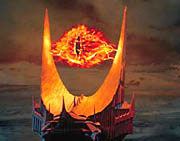
|
|
|
The Great Eye of Sauron, from the movie, The Lord of the Rings: The Fellowship of the Ring. This is the form that Sauron took during
the Third Age, as his body had been destroyed at the end of the Second Age. Note that the eye is between two pillars.
|
|
It was then determined by a council of wise elders that this magic ring was in fact the One Ring that had once belonged to Sauron. It had also been discovered that Sauron had recently begun to reform his power in Middle-Earth and had begun to rebuild his armies in his old territory of Mordor, where he now appeared as a great, flaming eye at the top of a tall tower. The ring, it seems, had kept him from dying completely, as his life force was still linked to it, and it to him. It was further determined that the ring was too powerful and too evil for anyone to wield, as it would eventually corrupt them — Sauron had poured too much of his wickedness and malice into the ring to make it usable. Finally, it was found out that Sauron's spirit, long dormant, was slowly reviving, and he had begun to look for the One Ring again so that he could regain his former strength. And if he was able to find it, he would regain his former strength and become powerful enough to defeat all the armies of Middle-Earth — which had become weakened since the last war — and cover all of Middle-Earth in a second darkness.
It was therefore decided that the ring had to be destroyed. And the only place that the ring could be destroyed was in the fires of Mount Doom — the volcano in which it had been forged. From this came the quest to destroy the ring that forms the basis of the storyline of The Lord of the Rings (hereafter, "LOTR").
|
|
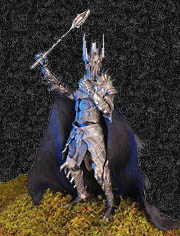
|
|
|
A reproduction of Sauron as he appeared in the Second Age, as portrayed in the movie, The Lord of the Rings: The Fellowship of the
Ring. Note the upraised mace.
|
|
Before now, understanding what I am terming "The Lord of the Rings Cipher" was impossible. The connection between Osiris, Pharaoah Narmer, Nimrod, the Great Pyramid, the fallen angels, a dark lord, a powerful ring, two towers, and a catfish of all things, sounds ridiculous outside of the context of our series on ancient Osiria. However, as we have discovered in this series, much has been hidden that is now being revealed, and Tolkien, who is considered to be one of the great minds of the twentieth century, may have been an even greater genius than even his most fervent acolytes have previously imagined.
Tolkien wrote LOTR not as simple entertainment, nor as an allegory of World War II (though he doubtless drew upon the terror of Hitler in his development of the character of Sauron, and of the blitz in his description of the Nazgul). Tolkien wrote LOTR as a warning of what was about to come upon the Earth. The dark lord, his ring of power, the great, flaming eye atop his towering throne, all were to come to pass in the not-to-distant future, as the great game of Azazel and the other fallen angels drew near to its end.
Sauron is, of course, Azazel, the fallen angel, also known generically as Satan (lit., "the enemy") in the Bible. His "One Ring" is his own will to power, and the lesser rings are his creation of a race of hybrid humans that are designed to be more easily controlled by him. These "ringwraiths" are under his direct control, and Azazel and the other fallen angels have used them and their descendants to slowly take control of the world behind the scenes, chipping away at the old order established by God from within. Interestingly, Sauron also used the same technique of quietly undermining and dividing his opponents over long periods of time before attacking.
The defeat of Sauron at the end of the Second Age of Middle-Earth is cognate to the defeat of the fallen angels at the end of the age before the Flood. (Interestingly,
as we have seen,
the Hopi Indians of the Desert Southwest also believe that the Earth is presently in its Fourth Age, and that the previous, Third Age had been destroyed by a Flood.)
Tolkien's emphasis on the fact that the ring was buried in the muck at the bottom of a body of water is also cognate to the fact that the ancient world and the fallen angels had also been buried beneath water. Moreover, the recovery of the ring was closely associated with fish, in this case the catching of a fish that dragged the hobbit Deagol down to the depths of the water.
|
|
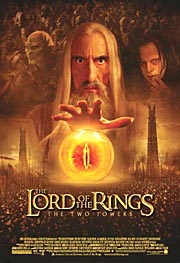
|
|
|
In
The Two Towers,
the character
Saruman
was seduced by the dark side and turned his abilities towards evil. This evil took the form of abandoning nature and instead
embracing industrialization, the most horrid aspect of which was the genetic manipulation of men and other species.
Image from
Lord of the Rings.net.
|
|
Perhaps most importantly to our present study, the ring turned the Hobbit Smeagol into the bottom-feeding, selfish, bipolar schizophrenic wretch named Gollum whose favorite food was catfish — the symbol of Narmer. Interestingly enough, the helmet of Sauron as specifically designed for the movie adaptation of LOTR (above) is unusual in that the faceplate appears to have tentacles reminiscent of the image of the catfish found on
Pharaoh Narmer's serekh. It particularly looks like the catfish portrayed in Narmer's serekh
when viewed from above, the shape of the eyes and the curve on the top of the helmet also correlating. Even Sauron's use of a mace is highly reminiscent of the classic "upraised arm" pose shown on the Narmer Palette. Could Tolkien and/or the designer of this helmet have been making a subtle allusion to the mysterious Pharaoh Narmer, the "Catfish King", which may have been Tolkien's inspiration for Sauron?
And there is much more. The "Two Towers" featured prominently in LOTR are an allusion to the two pillars to which Azazel was chained as punishment for corrupting the world before the Flood, and of the two tower hieroglyphs in Narmer's serekh shown symbolically imprisoning the catfish. The destruction (or conquest) of these towers in LOTR was a warning that two towers would be destroyed in the near future by Azazel as part of the last stage of his freeing himself from his prison right before his takeover of the whole world. And in 2001, the "two towers" that Azazel has been chiseling away at for so many thousands of years have at last (symbolically) fallen, and he is now loose from his ancient prison between the pillars.
Though there are many more parallels we could examine, the most prominent, and critical final warning from Tolkien comes in the form of the great "eye" at the top of the tower. As we have seen in
Part II
of this series, the Great Pyramid was in fact not a mere monument, nor a tomb, but a method for generating electrical power and communications that had been turned from its beneficial purpose to cause destruction. Once used as a massive free energy device in function identical to a Tesla Tower, the great pyramid was turned into what one author has termed "the Giza Death Star" that sparked the last great world war of the antediluvian world. And this pyramid was, in appearance, essentially a great flaming eye atop a tall tower. It is this great weapon that Azazel and his masonic minions are striving to recreate in order to use it to once again try to conquer and enslave the entire world. This is why the symbol of the Freemasons is a great eye inside a pyramid, and their motto is
novus ordo seclorum
— "a New Order of the Ages" — they intend to free themselves from God's rule, recreate the great weapon, and then use it to conquer the world.
|
|
|
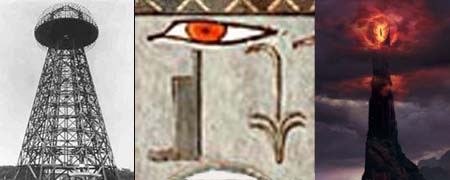
|
|
|
Left: Tesla's behemoth tower, to be used for trans-Atlantic wireless communications and the demonstration of wireless power
transmission, erected in 1901 at Wardenclyffe (now Shoreham) on Long Island.
Center: The hieroglyph for the Egyptian god Horus, which is simply the all-seeing eye over a throne. The plant to the right
was a later addition by the strange, superstitious religion of the dynastic Egyptians.
Right: The eye of Sauron — yet more evidence that J.R.R. Tolkien was a genius.
Sauron image from
The Art of the Return of the King
|
|




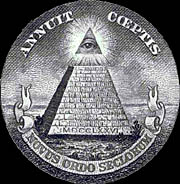
|
|
|
The All-Seeing Eye of the freemasons atop a pyramid, with the motto "a New Order for the Ages" along the bottom decorates every dollar bill.
Image from
InfoWars.com.
|
|
|
As part of the last stages of "the great game" wherein Azazel and the fallen angels will finally free themselves from their ancient prison, their masonic minions had to escape the Old World and create a new country wherein they could have the freedom to move and speak freely so as to begin rebuilding the world as it had been before the Flood. To this end, "America" was created, a "New Atlantis" that was ostensibly intended to be a place of religious and other freedoms, but whose secret agenda was as a base from which to rediscover the forbidden technologies of the antediluvian world and use them to conquer the world. America, though quite possibly the greatest country the world has ever seen, full of some of the best people the world has ever seen, is far from perfect. In fact, in recent decades America has turned from a primarily moral and ethical nation into a place where pretty much anything goes. Once the beacon of chastity and temperance for the world, America's popular culture is essentially a "whore culture", a free-sex society with few if any remaining restrictions. Becoming increasingly free of God's Law, cultural traditions, and any semblance of morality, America has become an ideal environment for the spread of wickedness on a global scale like a virus — precisely the sort of place that the fallen angels had planned. By removing God's Law and other moral and ethical restrictions in the name of "freedom" and "tolerance", Americans have been morally weakened, divided, and set up to be enslaved.
This may well be why John the Revelator used the metaphor of "the Great Prostitute" to describe New York City and the increasingly decadent culture of the U.S. It may well be that the forces of the Beast have purposely promulgated an "anything goes" mentality that has led to such immorality in this country, full well knowing that without a strong moral center and cultural traditions, a country is much easier to enslave. For this reason, the beast will allow the "whore" — American popular culture — to ride him until she has done her job of morally corrupting and greatly weakening America (and many other countries around the world). Then, when the whore has sufficiently weakened and undermined the morals and cultural traditions, replacing them with the global
"whore culture"
we are seeing today, he will destroy her and conquer the now decadent and weakened peoples. This is the initial act in the "endgame", the end of the great game — the enslavement of the entire world. And it started on
9/11/2001.
In the final phase of the Great Game, the "Endgame", the fallen angels and their masonic minions will create a false crisis, and an enemy leader that is a straw man — i.e., a fake opponent who is either a dupe or secretly working for the masons. Osama Bin Laden is most likely this dupe, and the destruction of the two towers was the
"Reichstag Fire"
that gave the powers that be the excuse to start the last great world war. As a result of the activity of this "false prophet" (let the reader understand), mankind will willingly allow themselves to be enslaved due to the fake "terrorist threat". The last great world war will then result in the total conquest of Earth and consolidation under one government. And once that is accomplished, mankind will be easily enslaved. At that point only an outside force will be able to save mankind from permanent enslavement — or annihilation in favor of a "superior" form of mankind. And this outside force will be "The Return of the King", Jesus Christ, who will utterly destroy the forces of Azazel and his minions. But this conquest will not take place without a struggle, which is where "the Great Eye" comes in.
In Matthew 24, Jesus makes a rather mysterious statement:
So when you see standing in the holy place "the abomination that causes desolation," spoken of through the prophet Daniel — let the reader understand — then let those who are in Judea flee to the mountains.
( Matt. 24:15-16 )
The term "abomination that causes desolation" literally means a profane, foreign object that is placed in a holy place where it does not belong, and the result of its inappropriate placement results in great destruction. In this case, it refers to an extemely profane object being placed in the Third Temple in Jerusalem, which has yet to be rebuilt. No one knows what that object is, but our analysis may lend us some clues as to what that object might be.
|
|
|
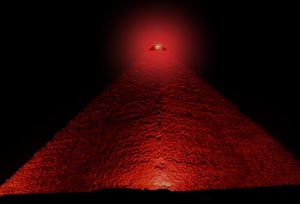
|
|
|
The "Great Eye" of the antediluvian world, and the inspiration for the Great Eye of Sauron.
Click here
for a detailed explanation of how it worked.
|
|
As we have seen, the
freemasons
are part of an ancient tradition that stretches all the way back to ancient Egypt and Mesopotamia. Even today their rituals incorporate references to Solomon's Temple and Hiram, the Phoenician builder whom Solomon had contracted to build the temple. In fact, probably the sole reason for the existence of the
Freemasons
is to build the Third Temple. However, the Third Temple will not be holy like the first two (truly, only the First Temple was holy). It will be a false temple created for the purpose of enslaving mankind, and the "abomination of desolation" placed within it will be a false ark that will make the Third Temple not a means of healing the nations, but a Great Weapon to conquer them. It will be the penultimate manifestation of Satan's power and will to dominate others — "One Ring to Rule them All", as it were. In it, the master design of Azazel and the other fallen angels to escape the control of God and found a kingdom of their own on Earth will come to its fruition — in it, the great "ring", or spell that he cast in elder times will finally come to pass. It is this Great Weapon, this "abomination of desolation", that will be the primary weapon of Azazel, the Beast from the Sea, that he will use to oppose the Return of the King.

Pharaoh Narmer
|
The Great Game
|
The Fisher Kings
|
The Beast from the Sea
The Lord of the Rings Cipher
|
Endgame
Osiria Links
|
Osiria Books
|
Osiria Audio
|
Osiria Video
|
Osiria Collectibles
Part I: The Athenian Empire
|
Part II: Antediluvian Egypt
|
Part III: Nimrod Hunting
NEW!
Ah, Osiria! Discussion Board
(Requires Registration)
Editorial
|
Press Releases
|
Book Reviews
|
Fragments
NEW! Artifacts: Coral Castle
Grand Canyon II
|
Giants IV
|
Osiria IV
Register
for our Hall of Records Newsletter!
Questions? Comments? Suggestions? Advertising? Press Releases?
Contact us!

1
Marie Parsons,
"King Catfish, also called Narmer"
(Tour Egypt: http://www.touregypt.net).
2
The exact location of the prison the fallen angels had been thrown into by the archangels as punishment for corrupting the antediluvian world is unclear, though the sea floor could well be one of the places where they were cast down and buried. See
The Legend of Atlantis: The Antediluvian World
for more background information,
Giants in the Earth: Giants of the Ancient Near East
for more information on the reappearance of the giants in the world after the Flood, and
Ah, Osiria!: The Athenian Empire
for more information specifically about the giant Osiris.
3
Parsons,
"King Catfish, also called Narmer".
4
Bruce Magnotti,
"Oannes.com: The Origins of Our Civilization"
(OANNES - The Origins of Western Civilization: http://oannes.com/).
5
Laurence Gardner,
Bloodline of the Holy Grail
(Gloucester, MA: Fair Winds Press, 1996), 150.




D E I T I E S & D E M I G O D S
Osiris:
 EgyptianMyths.net: Osiris
EgyptianMyths.net: Osiris
 University of Colorado: Osiris
University of Colorado: Osiris
 EgyptianMyths.net: The Story of Isis and Osiris
EgyptianMyths.net: The Story of Isis and Osiris
 TourEgypt.net: Osiris, Asar
TourEgypt.net: Osiris, Asar
 Ohio State University: Osiris
Ohio State University: Osiris
Orion:
 Nimrod as Constellation of Orion
Nimrod as Constellation of Orion
 Wikipedia: Orion (mythology)
Wikipedia: Orion (mythology)
 The Mythology of the Constellations: Orion, the Hunter
The Mythology of the Constellations: Orion, the Hunter
 Mythology Guide: Orion
Mythology Guide: Orion
 Theoi Project: Orion
Theoi Project: Orion
 Orion (the Constellation)
Orion (the Constellation)
 Lexiline: Sumerian Sky Map of Nineveh
Lexiline: Sumerian Sky Map of Nineveh
 The Celestial Sphinx, a Sumerian Cylinder-seal and the Place of Purification
The Celestial Sphinx, a Sumerian Cylinder-seal and the Place of Purification
Oannes:
 Oannes - The Origins of Western Civilization
Oannes - The Origins of Western Civilization
 Oannes - The Herald of Western Civilization
Oannes - The Herald of Western Civilization
 Encylopedia Mythica: Oannes
Encylopedia Mythica: Oannes
 The Story of Oannes
The Story of Oannes
 Who Is Oannes?
Who Is Oannes?
Ea:
 Encylopedia Mythica: Ea
Encylopedia Mythica: Ea
The Fisher King:
 The Fisher King
The Fisher King
 Arthurian Legends Illustrated: Part IV. Healing the Fisher King
Arthurian Legends Illustrated: Part IV. Healing the Fisher King
K I N G S & H E R O E S
Pharoah Narmer:
 King Catfish, also called Narmer
King Catfish, also called Narmer
 Aha! Or is it King Menes?
Aha! Or is it King Menes?
 The Narmer Palette: The Victorious King of the South
The Narmer Palette: The Victorious King of the South
 The Narmer Palette: King of the North
The Narmer Palette: King of the North
 The Alpha and the Omega: The Protodynastic [Predynastic] Period
The Alpha and the Omega: The Protodynastic [Predynastic] Period
 The Alpha and the Omega: The Obverse Side of Narmer's Palette - The Bull Interpretations
The Alpha and the Omega: The Obverse Side of Narmer's Palette - The Bull Interpretations
 The Alpha and the Omega: The Reverse Side of Narmer's Palette - The Upper, First, Second and Third Registers
The Alpha and the Omega: The Reverse Side of Narmer's Palette - The Upper, First, Second and Third Registers
 Ancient-Egypt.org: The Narmer Palette
Ancient-Egypt.org: The Narmer Palette
 Ancient-Egypt.org: Narmer's Titulary
Ancient-Egypt.org: Narmer's Titulary
 Narmer: The Narmer Palette
Narmer: The Narmer Palette
 Eternal Egypt: King Narmer: The Narmer Palette
Eternal Egypt: King Narmer: The Narmer Palette
 Audrey's Ancient Egypt: The Narmer Plate is a Sky Chart
Audrey's Ancient Egypt: The Narmer Plate is a Sky Chart
 Narmer Serekh Sign
Narmer Serekh Sign
 Ancient Egypt: The Mythology - Serekh
Ancient Egypt: The Mythology - Serekh
 Tour Egypt: Serekh
Tour Egypt: Serekh
 The 'God with the Upraised-Arm' in Near Eastern Mythology: An Astronomical Archetype?
The 'God with the Upraised-Arm' in Near Eastern Mythology: An Astronomical Archetype?
T R A V E L:
 Visiting Mesopotamia - Iraq, the cradle of civilization
Visiting Mesopotamia - Iraq, the cradle of civilization
 Picture Iraq
Picture Iraq
 Bet-Nahrain, Inc.
Bet-Nahrain, Inc.
 The Virtual Babel Encyclopedia
The Virtual Babel Encyclopedia
 Photoseek: Nemrut Mountain
Photoseek: Nemrut Mountain
 To My Turkey: Nemrut Dagi (Mt. Nimrod)
To My Turkey: Nemrut Dagi (Mt. Nimrod)
 Turkey Travel Planner: Nemrut Dagi, Eastern Turkey
Turkey Travel Planner: Nemrut Dagi, Eastern Turkey


 Bloodline of the Holy Grail
Bloodline of the Holy Grail
Laurence Gardner
Rating:   
Though Mr. Gardner's conclusions regarding a supposed "bloodline of Jesus" are not well founded, his research into the heretical teachings of the Templars, Cathars and related gnostic groups, as well as insights into some of the religious motivations behind European history, are worth a look Particularly interesting and important is his research into the Merovingian line of kings that believed that they had descended from a "Beast from the Sea". (Review by Mysterious World)
Click
here
to buy this book.
 Myths from Mesopotamia: Creation, the Flood, Gilgamesh, and Others (Oxford World's Classics)
Myths from Mesopotamia: Creation, the Flood, Gilgamesh, and Others (Oxford World's Classics)
Stephanie Dalley (Editor), C. J. Fordyce
These tales from the ancient civilizations of the "fertile crescent" stand alongside the Odyssey and the Arabian Nights in being popular with an international audience at the dawn of recorded history. Here are myths of the Creation and of the Flood, as well as the fascinating Epic of Gilgamesh, a story of heroic failure in a moment of human weakness. (Review by Amazon.com)
Click
here
to buy this book.
The Sumerian King List
Thorkid Jacobsen
Rating:     
Click
here
to buy this book.
 "I Studied Inscriptions from Before the Flood":
"I Studied Inscriptions from Before the Flood":
Ancient Near Eastern, Literary, and Linguistic Approaches to Genesis 1-11
Richard S. Hess, David Toshio Tsumura (Editor)
Rating:     
Click
here
to buy this book.
 Ancient Near Eastern Texts Relating to the Old Testament with Supplement
Ancient Near Eastern Texts Relating to the Old Testament with Supplement
James B. Pritchard (Editor)
Rating: 




Prichard's ANET is a standard reference for those examining the cultural setting of the Bible. It contains translations of many important inscriptions which shed light on otherwise mysterious Bible customs. Generally regarded as a scholarly work, it's worth checking out for the layperson as well. Some of the jargon may be a little tricky, but there's no substitute for original source material, which makes up the majority of the book. Besides, some of the stories are just a plain old (very old) good read. Included are such things as the Epic of Gilgamesh (containing our oldest Flood parallels), the Nuzi Texts (which help us understand the life of Jacob, among others), and various of the ancient law codes which have parallels to the biblical code. Tremendously useful for study! (Review by Amazon.com)
Click
here
to buy this book.
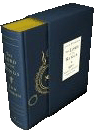 The Lord of the Rings (50th Anniversary Edition)
The Lord of the Rings (50th Anniversary Edition)
J. R. R. Tolkien
Rating:     
The Fellowship of the Ring, part one of J.R.R. Tolkien�s epic masterpiece, fist reached these shores on October 21, 1954, arriving, as C. S. Lewis proclaimed, "like lightning from a clear sky." Fifty years and nearly one hundred million American readers later comes a beautiful new one-volume collector�s edition befitting the stature of this crown jewel of our list. With a text fully corrected under the supervision of Christopher Tolkien to meet the author�s exacting wishes, two large-format fold-out maps, a ribbon placemarker, gilded page edges, a color insert depicting Tolkien's own paintings of the Book of Mazarbul and exceptionally elegant and sturdy overall packaging housed within an attractive slipcase, this edition is the finest we�ve ever produced.
Click
here
to buy this book.

 The Lord of the Rings: The Two Towers [SOUNDTRACK]
The Lord of the Rings: The Two Towers [SOUNDTRACK]
Howard Shore
Rating:     
Howard Shore's music for the massively successful first film chapter of Tolkien's Ring saga won him the Oscar� for Best Original Score, something of a surprise given the music's ambitious scale and determinedly dark overtones, factors that handily blurred the line between typical film fantasy music and accomplished concert work. Its sequel takes the same, often Wagnerian-scaled dramatic tack, following the film's story line into even more brooding and ominous dark corners. The previous film's Hobbit-inspired pastoralism is supplanted here by rich ethnic textures that expand the musical scope of Middle-earth and the World of Men; the Hardanger, a Norwegian fiddle, represents the Rohan and the North African rhaita colors the Mordor theme, while log drums, dilruba, wood xylophone, and cimbalon add intriguing textures elsewhere. The score's looming orchestral clouds are brightened by Shore's masterful choral writing, which infuses ancient liturgical influences with various solo turns by Isabel Bayrakdarian, indie-pop star Sheila Chandra, Ben Del Maestro, and Elizabeth Fraser. "Gollum's Song," the composer's concluding collaboration with lyricist Fran Walsh, is delivered with Bj�rkish, postmodern angst by Emiliana Torrini, and helps punctuate the story's modern sense of allegory.
Click
here
to buy this CD.
 Chariots of Fire
Chariots of Fire
[ORIGINAL RECORDING REMASTERED] [IMPORT]
Vangelis
Rating:     
One of the most memorable soundtracks of all time, Vangelis's Academy Award-winning Chariots of Fire is such a landmark, it's become the stuff of parody whenever someone wants to punch a hole through sloppy sentimentality. But just go back to this 1981 film to relive a perfect marriage of image and music. Vangelis captures the heroism, grandeur, and pain of this racing drama, from the opulent main "Titles" theme with its echoing snare drum and piano cadences to the electronically abstract setting of Sir Charles H.H. Parry's choral work, "Jerusalem." Vangelis's score hangs suspended between orchestral lushness and electronic mood, sweetness tempered by the underlying psychological themes of the film. Often forgotten on this album is the extemporaneous title suite that, in the days of LPs, took up the second side of the album. Here, Vangelis explores some of the film's music cues at length, weaving them into a minor keyboard symphony.
Click
here
to buy this CD.
 Raiders Of The Lost Ark [SOUNDTRACK]
Raiders Of The Lost Ark [SOUNDTRACK]
John Williams
Rating:     
The first of the three Indiana Jones scores, Raiders established the popular Raiders March Theme as an instant classic in the world. As easily recognizable as the Star Wars fanfare, John Williams' Raiders March is the first track on this expanded edition of the Raiders soundtrack, from there it becomes a great thrillride that follows Indy's adventures to find the Ark. Along with the standard music there are some bonus tracks that were not previously published before. The insert has an interview with John Williams, pictures from the making of the movie and a break down of the tracks. This is a superior soundtrack recording and unlike the more mature sound to Indiana Jones and the Last Crusade, has many more instances where the Raiders March is used. Other themes to listen for include the ark theme, which makes a brief reappearance in Last Crusade, is used many times here as well as the love theme for Indy and Marion.
1995 reissue. 30 additional minutes have been interwoven which were deleted from the original 1981 release, totaling 74 minutes of pure listening pleasure. Re-mastered including a special 24 page booklet containing an interview with John Williams, as well as liner notes, rare photos and sketches not included with the original release. Standard jewel case housed in a slipcase. Top notch.
Click
here
to buy this CD.
 Beauty in the Beast
Beauty in the Beast
Wendy Carlos
Rating:     
From the roar of Tibetan horns and the clangor of metal percussion that opens Beauty in the Beast, Wendy Carlos in 1986 signaled a new direction for her music. Beauty in the Beast is Carlos's magnum opus, an album that should have established the synthesizer's role in the new global music landscape. More than that, it should have established Carlos as a composer and not just a Switched-on Bach jukebox. But not too many people were listening. Rereleased now after 14 years, Beauty in the Beast has lost none of its power. Carlos is both profound and poignant, dissonant and disarming on Beauty, as she fuses a global orchestra from her synthesizers. "Poem for Bali" is the centerpiece of the album, an episodic, 17-minute excursion as Carlos orchestrates the sounds and rhythms of a digital gamelan orchestra. In addition to replicating the metallophones, gongs, and flutes of the traditional gamelan, she creates her own hybrid sound designs, giving this work a surreal and sometimes harrowing tone, like a dream bent through funhouse mirrors. But then there are pieces such as "A Woman's Song," based on a Balkan melody. The title track merges nightmare landscapes and a crazed carnival calliope with a haunting theme that sounds like a lament for the end of the world. Beauty in the Beast is an essential recording of both modern composition and synthesis--Carlos should plug into this circuit again.
Click
here
to buy this CD.

 The Lord of the Rings - The Two Towers
The Lord of the Rings - The Two Towers
(Platinum Series Special Extended Edition)
(2002)
Rating:
    
Not seen in theaters, this unique version of the epic adventure features over 40 minutes of new and extended scenes integrated into the film by the director. DVD set consists of four discs with hours of original content including multiple documentaries, commentaries and design/photo galleries with thousands of images to give viewers an in-depth behind-the-scenes look at the film. Frodo Baggins and the Fellowship continue their quest to destroy the One Ring and stand against the evil of the dark lord Sauron. The Fellowship has divided and now find themselves taking different paths to defeating Sauron and his allies. Their destinies now lie at two towers — Orthanc Tower in Isengard, where the corrupted wizard Saruman waits and Sauron's fortress at Baraddur, deep within the dark lands of Mordor.
(Review by Amazon.com)
Click
here
to buy this DVD.
 The Fisher King
The Fisher King
(1991)
Arthurian mythology and modern day decay seem perfect complements to each other in this Terry Gilliam drama/comedy/fantasy. Shock jock Jack Lucas (Jeff Bridges) makes an off-handed radio remark that causes a man to go on a killing spree, leaving Lucas unhinged with guilt. Lucas's later, chance meeting with Parry (Robin Williams), a homeless man suffering from dementia, gets him involved in the unlikely quest for the Holy Grail. The rickety, and patently unrealistic stand that insanity is just a wonderful place to be, and that the homeless are all errant knights, wears awfully thin, but there are numerous moments of sad grace and violent beauty in this film. The screenplay by Richard LaGravenese launched his successful career and his smart wordplay helped garner Mercedes Ruehl an Oscar as Lucas's girlfriend.
(Review by Amazon.com)
Click
here
to buy this DVD.

 The Lord Of The Rings Fellowship Of The Ring 10" Sauron Deluxe
The Lord Of The Rings Fellowship Of The Ring 10" Sauron Deluxe
Rating:
    
The great evil who is seeking to rule Middle Earth has been masterfully crafted into a 10" action figure. Adorned in intricately detailed armor, Sauron features 16 points of articulation. He holds his evil mace and wears a shrouded back cape. Sauron wears "the one ring to rule them all," which is lost when his fingers are realistically severed. His eyes light up red as he electronically speaks four different phrases from the movie.
Click
here
to buy this collectible.
 The One Ring
The One Ring
Rating:
    
One Ring to Rule Them All. One Ring to Find Them,
One Ring to Bring Them All, And in the Darkness Bind Them!
The One Ring...Isildur's Bane, the Ring of Power...forged in the fires of Mount Doom by Sauron himself! Now you, too, can be a Ringbearer, if you dare...
Bearing the Black Speech of Mordor, transcribed into beautiful, flowing Elvish script which is laser engraved, these rings are reproductions of the One Ring you have seen in the movies, and are fully licensed by New Line. The Elvish script is both inside the rings as well as outside. A certificate of authenticity accompanies this recreation of The One Ring.
Click
here
to buy this collectible.
Editorial
|
Press Releases
|
Book Reviews
|
Fragments
NEW! Artifacts: Coral Castle
Grand Canyon II
|
Giants IV
|
Osiria IV
Register
for our Hall of Records Newsletter!
Questions? Comments? Suggestions? Advertising? Press Releases?
Contact us!
|

